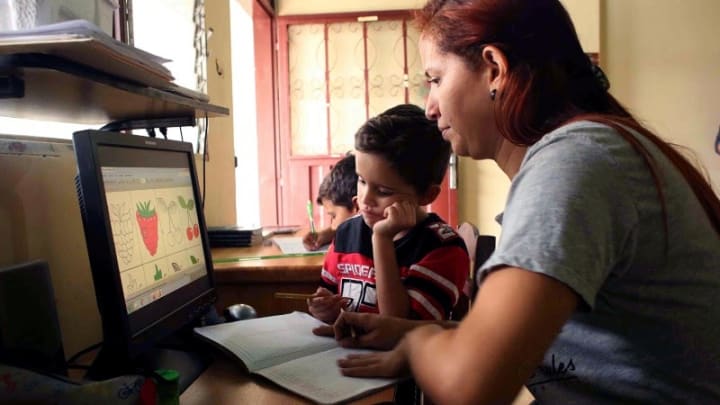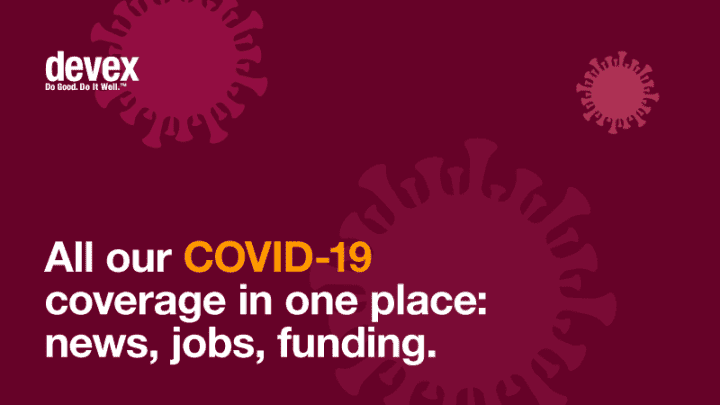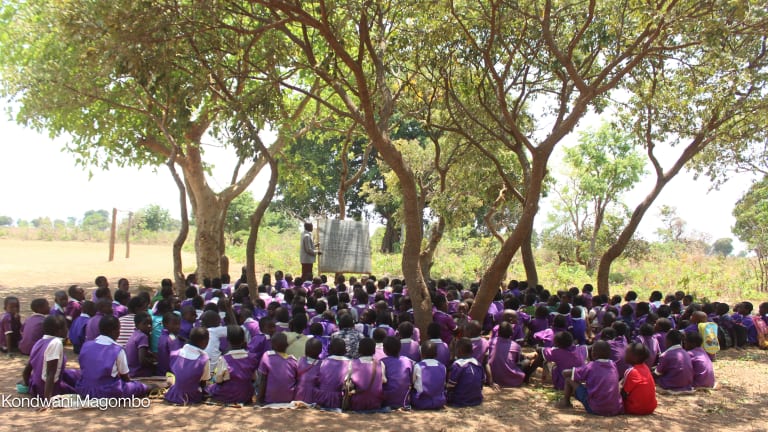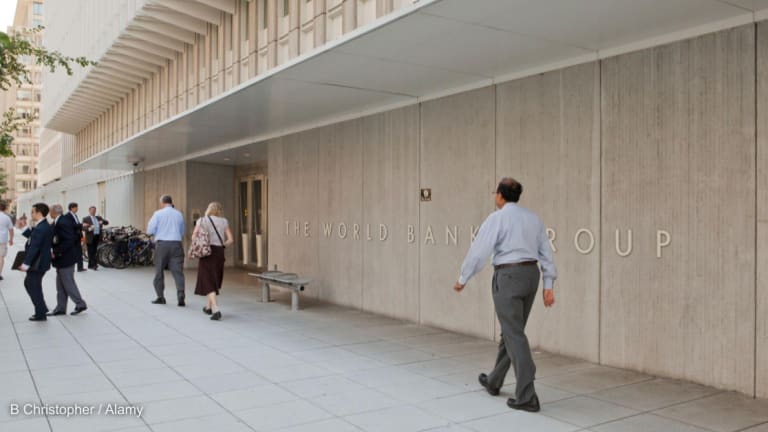
WASHINGTON — COVID-19 has forced more than 1.5 billion children out of school, leaving governments, donors, and NGOs scrambling to mitigate the largest concurrent disruption to the global education system.
COVID-19 — a timeline of the coronavirus outbreak
Follow the latest developments on the new coronavirus that causes COVID-19.
The development community and humanitarian system are mobilizing programs and funding to keep children learning out of the classroom for an indefinite period of time, a response that UNICEF Global Chief of Education Rob Jenkins said requires “all hands on deck.”
“We’ve never had anywhere close as many kids out of school at same time,” Jenkins said, emphasizing that a crisis of this magnitude will affect every child differently. “The impact of this pandemic on education is just so unprecedented that while the commitment is there, I must admit there’s also just a sense of overwhelm that we need to work through in order to translate into tangible action.”
“The education sectors of the world suffer from huge inequities and we already know that there’s a learning crisis ... I think it’s going to make people rethink: ‘How much do we have to invest in this?’”
— Alice Albright, CEO, Global Partnership for EducationAs the pandemic threat grew around the world, UNICEF mobilized its country offices in 145 countries to engage with national governments and begin formulating a system-wide response in each country to school closures. Drawing on lessons learned when the West African Ebola epidemic closed schools for months at a time, Jenkins said it is important to note that responses must be context-specific.
Low-tech solutions can include driving textbooks or materials to students’ homes, while those with access to computers and internet can benefit from online learning.
UNICEF is now working to monitor the response of school systems around the world to make context-specific adjustments in real time. In South Asia, for example, only 33% of people have access to the internet, leaving parents who are illiterate or didn’t finish their own education as ill-equipped stand-ins for trained teachers.
“It requires understanding the data, understanding the tools that are available and which children have access to which tools and which platforms and how to reach them in each context,” Jenkins said.
He added that UNICEF has seen a huge percentage of partner countries engaging with radio, television, and printed materials, while engagement from teachers through phone calls and WhatsApp messages can also work in some contexts.
UNICEF is allocating existing education money toward its response to the pandemic, as well as engaging other donors to mobilize additional funds focused on creating a continuity in learning. Because the vast majority of education resources come from governments themselves, Jenkins said strained national budgets could deprioritize the sector.
Alice Albright, CEO at the Global Partnership for Education, is also concerned about availability of education funding once the COVID-19 outbreak is over and children are back in school. Education is already underfunded, she said, and many countries will be experiencing budget strain from economic slowdowns caused by the pandemic.
“Countries are concerned about the macroeconomic impact — what does it mean for them generally, their overall budget — but what does that mean for the poorest and most vulnerable families?” Albright said.
“The education sectors of the world suffer from huge inequities and we already know that there’s a learning crisis ... I think it’s going to make people rethink: ‘How much do we have to invest in this?’”
In response to the education crisis caused by COVID-19, GPE has allocated $250 million to mitigate both current and future adverse impacts on the sector. Of that money, $225 million will be invested in countries, while $25 million will be invested in global and regional activities to help countries share ideas about approaches that are working. The funds will be distributed on a first-come, first-served basis, with some reserved for vulnerable countries, and those who receive money must follow GPE criteria for how it can be spent.
“We work with country governments, listen to them, understand their priorities and help fund those. So we’re not going to be prescriptive,” Albright said.
“We expect the countries will be applying for a range of things that could include anything from ensuring that learning can continue, to producing radio and other medium[s] of educational materials to get distributed,” to supporting teachers and collecting data to figure out how to reopen schools.
Supporting teachers and parents
WFP repackages efforts to reach hungry children as COVID-19 closes schools
While the COVID-19 pandemic pushes a growing number of schools to close, the World Food Programme is developing new strategies to reach the 11.6 million out-of-school students who rely on the agency's daily lunches.
In many low-income countries, schools are not only places of learning, but also act as community hubs where children and families receive a variety of services. Closures cause a disruption in learning as well as access to proper nutrition through school feeding programs, safe water supply, psychosocial support, and health care services.
School can also be a place where children find much needed routine and safety. Protection risks can increase when kids are at home, Jenkins said, because they could be quarantined in an abusive environment. Additional economic or health stress from the current situation could exacerbate tensions in some homes and pose a risk to children.
Save the Children Vice President of International Programs David Barth said this protection risk is a focus for his organization as it responds to the education crisis.
“What we care deeply about is the mental health, the psychosocial aspect of this,” Barth said. “We are profoundly concerned that kids who may be in places where they’re generally subjected to violence, it could be augmented because of the pressure of higher unemployment, the proximity, stress on the family, all of the other aspects.”
Students aren’t the only ones who need support during the time they are out of school, Barth said. Parents and teachers also require assistance in how to adapt to this unprecedented situation. Communication with parents is key to get buy in for distance learning programs and to ensure any technology needed, like a radio or television for broadcast lessons, is available for a child during the day and not occupied by another member of the household.
An existing worldwide teacher shortage could be exacerbated by the pandemic, Barth said, making it vital that teachers receive training they need to succeed in this new environment. Save the Children has employed tactics such as online forums and messaging systems with teachers in high-risk environments, like refugee camps, in the past.
“There’s already huge gaps in terms of teacher numbers we see normally, and it’s a tough job. In a lot of countries, particularly in these low resource settings, teachers don’t always get paid. Teachers don’t have the materials they need to do their job properly … What we want to do is help them maintain their motivation and their skills,” Barth said. “We want to make sure that they are both continuing their professional development and ... they’ll be ready to go back.”
Both UNICEF and Save the Children are looking ahead to the time when children will begin to reenter school and how they can ease the transition. That requires assessing where each child is at when they return, Jenkins said, and offering different options based on need, including accelerated learning that would allow them to catch up.
More funding will be needed, Albright acknowledged, depending upon how long students are at home. Prolonged school closures may keep some children in vulnerable situations from ever getting back in the classroom, she said, as was seen after Ebola.
This can be because they’ve had to take on roles as caregivers for siblings or elders, find work to economically support the family, or in the case of girls, be married off.
“We’re very optimistic we will be able to ensure kids continue on learning pathways and are able to reenroll, reenter school, and continue learning, but the risks are great indeed if that doesn’t happen: to each individual child that’s affected but also to their communities and the countries,” Jenkins said.
“Risks will increase, particularly in poorer countries, as the crisis prolongs.”
Visit our dedicated COVID-19 page for news, job opportunities, and funding insights.





